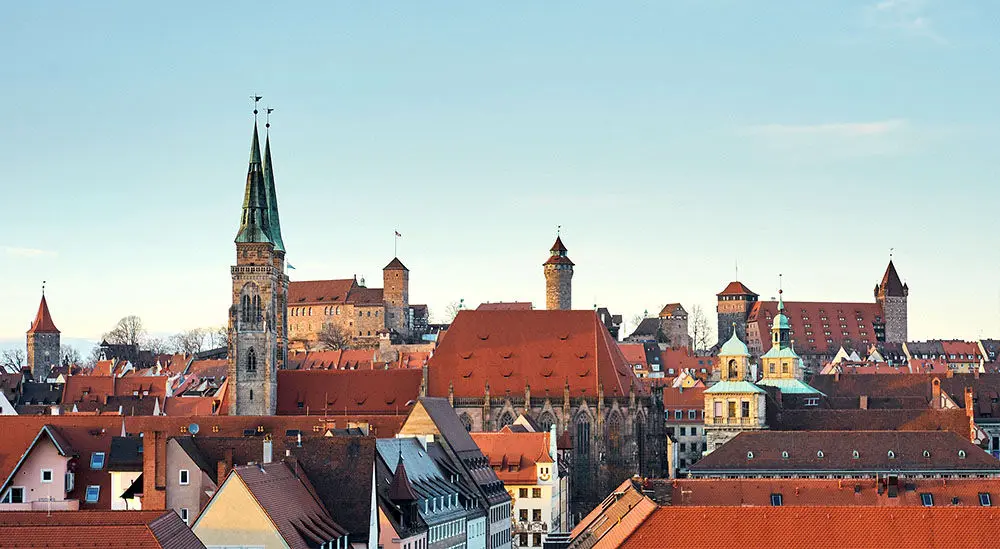
Audio 1: Introduction
Who amongst you is not familiar with it, the smell of fresh gingerbread or a Nuremberg bratwurst , a roast sausage? The Franconian city is found in the south of Germany and enchants with a historical past, picturesque architecture, and exciting sights. Nuremberg is the second largest city in Bavaria after Munich and has all kinds of things to offer visitors. The Kaiserburg and Albrecht Dürer are inextricably linked with Nuremberg, but there are many more attractive and interesting sights to explore here, which we will introduce to you individually with the audio guides below.
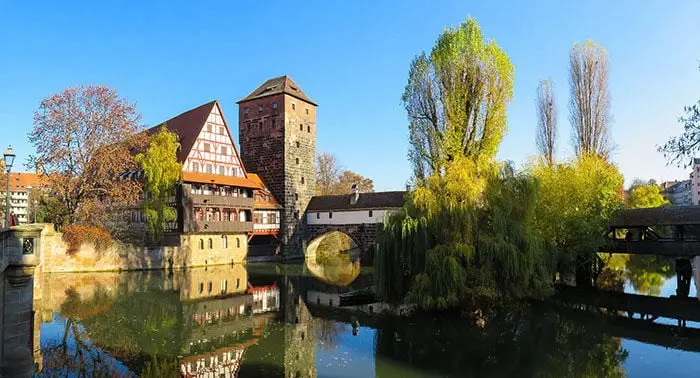
Audio 2: Nuremberg Castle (Kaiserburg), Part 1
The Nuremberg Castle, or Kaiserburg, is the landmark of Nuremberg. Since the Middle Ages, its silhouette has represented the power and importance of the Holy Roman Empire of the German Nation and the prominent role of the imperial city of Nuremberg.
The Nuremberg Imperial Castle is significant in several respects: As a complex of various fortified buildings, it forms one of the largest castle complexes in Germany. The Palas (the building wherein the rulers lived) is one of the most elaborate testimonies of its kind. The castle is a monument to the history of the Holy Roman Empire of the German Nation.
At its earlier stage, the Nuremberg Castle was fiercely contested over. Conquered in 1105 by Henry V in battle against his father Henry IV; the Staufers Conrad and Frederick defended it a short time later against Emperor Lothar of Supplinburg. Between 1050 and 1571, all the emperors of the Holy Roman Empire of the German Nation stopped at the castle, from the Salians to the Habsburgs. At times, the coronation insignia were kept in the castle chapel.
Frederick Barbarossa and his successors expanded the Salian castle on the western castle rock into one of the most magnificent castles of the empire. At that time, the imperial chapel, which has been preserved unchanged to this day, was built, and took on the functions of a court church, a private imperial chapel, and a regular castle chapel.
In the next audio, we shall explore the Burggrafenburg and the Kaiserburg with the audio guide.
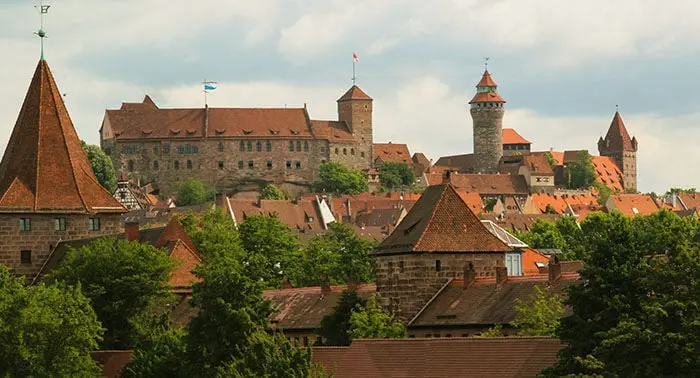
Audio 3: Nuremberg Castle (Kaiserburg), Part 2
The Nuremberg Castle consisted of two separate areas, the Burggrafenburg and the Kaiserburg. The Burggrafenburg begins with the "Fünfeckturm", a five-cornered tower, which is the oldest building of the complex. The keep, which was later connected to the imperial stables, dates to around 1150 and covered the entrance, which was additionally protected by a so-called neck ditch, which is now buried. The tower is built of humped ashlars and has a 2.6m thick wall; the entrance is 5m high. The reinforcing porch known as "Osteck", gives the tower its fifth corner and is a unique construction. From 1427 it was used as a prison. The remaining buildings of the Burggrafenburg were destroyed in the Middle Ages.
From the Freiung (or castle courtyard), the way leads to another round-arched gate in a shield wall made of bricks. It marks the entrance to the actual imperial castle and is flanked by the mighty "Sinwellturm", which means “huge and round”. This keep at the entrance to the outer courtyard dates from the time of the first Habsburg king, Rudolf I, and was built after 1270 from large regular ashlars.
The outer courtyard of the imperial castle houses half-timbered buildings date from the 15th and 16th centuries, including the well house with the certainly much older "deep well", which descends 50 meters into the rock.
The palace from around the year 1300 consists of a lower and upper hall. The interior was reconstructed during the reconstruction in 1934, the Gothic wooden staircase and the wooden girder construction were reconstructed according to the model of the crypt in the Seligenporten monastery church.
Adjacent to the palace is the residential wing with several plank parlors, the so-called “Kaisergemächern” (imperial chambers), which could be heated. The painting of the ceilings has been partially preserved, partially reconstructed in the 20th century. The trapezoidal "Kemenate" was originally another residential building from the 15th century, but it was destroyed during World War II and completely rebuilt in 1968.
The next stop on our audio tour is the former Nazi Party Rally Grounds.
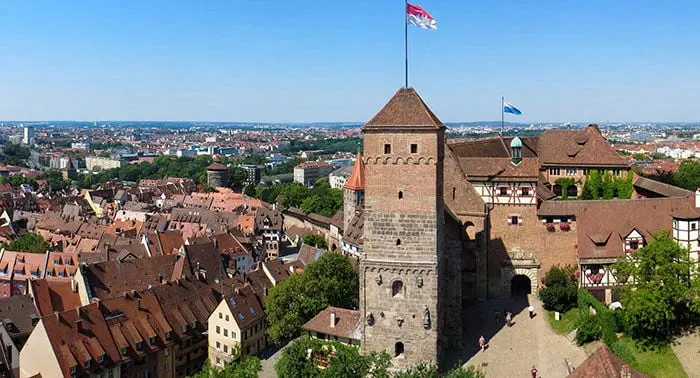
Audio 4: Former Nazi Party Rally Grounds (Reichsparteitagsgelände)
Adolf Hitler and his personal architect Albert Speer planned a “Tempelstadt der Bewegung” (temple city of the movement) on the approximately eleven square kilometers of the Nazi Party Rally Grounds. An area with huge assembly buildings and parade grounds was to be created, though it was only partially realized. By the outbreak of the war, the Zeppelin Field including the Zeppelin Grandstand, the Luitpold Arena and the Große Straße had been built. The construction of the Congress Hall did not get beyond the shell, and the stadium ended up as a construction pit that ran full of water. Something that was not deconstructed or built over after the end of the war - such as the March Field or the Luitpold Arena - has been a listed building since 1973.
The reference to antiquity is clear: the congress hall was built on the model of the Colosseum in Rome. It was intended to accommodate more than 50,000 people. A stone grandstand at the end of a huge parade field was based on the model of the Pergamon Altar: the Luitpold Arena. The gigantic German Stadium was to be modeled on the ancient stadium in Olympia and was to hold more than 400,000 spectators. By 1945, however, only the excavation pit had been dug. The great road, an extra-wide longitudinal axis through the temple district covered with enormous granite slabs, was however completed. It led from the Congress Hall to the March Field and was precisely aligned with the Kaiserburg - a tribute to Nuremberg as the city of imperial diets in the Middle Ages. Concentration camp prisoners were also used for the work. In the Flossenbürg, Groß-Rosen, Natzweiler-Struthof and Mauthausen concentration camps, they worked the stone for the Nuremberg monumental buildings under inhumane conditions.
Hitler's megalomania is still evident on the extensive grounds. The Congress Hall, to be specific, does not fail to make an impression: on gray days it appears gigantic and threatening. Despite or perhaps because of this oppressive impression, the past shall not be forgotten. If you want to find out more, you can use the audio guide to visit the Documentation Center of the Nazi Party Rally Grounds and the other buildings, learn about the site from 23 information panels, and then sit down on one of the surrounding meadows.
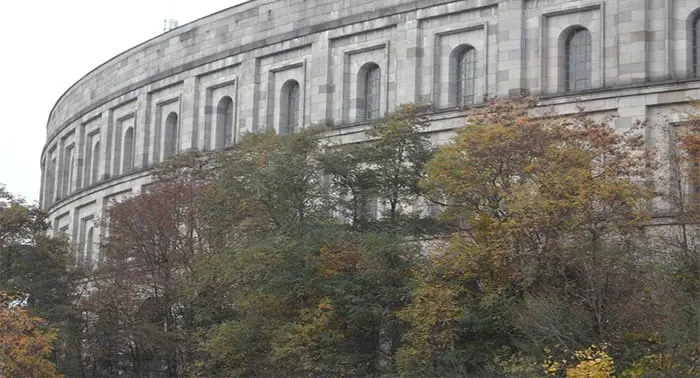
Audio 5: “Frauenkirche” (Church of Our Lady)
The Gothic Frauenkirche on the east side of the main market square is one of Nuremberg's three most important churches. What is world-famous about this structure are its balcony, whereon the annual Christkindlesmarkt (which you will learn more about in the next audio file) is opened yearly; as well as the art clock with the so-called "Männleinlaufen". This is a spectacle by Jörg Heuss (created 1506-09) on the Michaelschor gable. In memory of the enactment of the Golden Bull in 1356, the seven electors pay homage to Emperor Charles IV. The globe above the clock also shows the phases of the moon.
In 1355, Charles IV donated the Frauenkirche in Nuremberg as an imperial court chapel. The imperial insignia such as the imperial crown, mantle and scepter were to be kept there. This never happened, but the imperial insignia were first displayed to the public in the Frauenkirche during the celebration of the baptism of the heir to the throne, Wenceslas, in 1361.
The three-aisled Frauenkirche was the first Gothic hall church in Franconia. Peter Parler, most likely the master builder of the Frauenkirche, created a focal point in the interior for the presentation of the imperial regalia, as well as the balcony on the west front, where the Nuremberg Christkind (Christ-Child) speaks the prologue for the opening of the Christkindlesmarkt.
Stepping through the church's flower-covered entrance portal on the audio tour reveals a veritable rush of earthly gold and ecclesiastical splendor. The porch dates to the 14th century and is decorated with golden statues and bright colors.
If you tilt your head towards the ceiling, you will discover the impressive green-blue-gold painting with filigree tendril pattern and the ornated keystone. However, the portal not only survived the trials and tribulations of the Middle Ages, but also defied the bombing of Nuremberg in January 1945, which is why churchgoers and tourists can still admire the porch in all its glory, free of charge.
With the audio guide, we now move on to the annual Christkindlesmarkt held directly in front of the church.
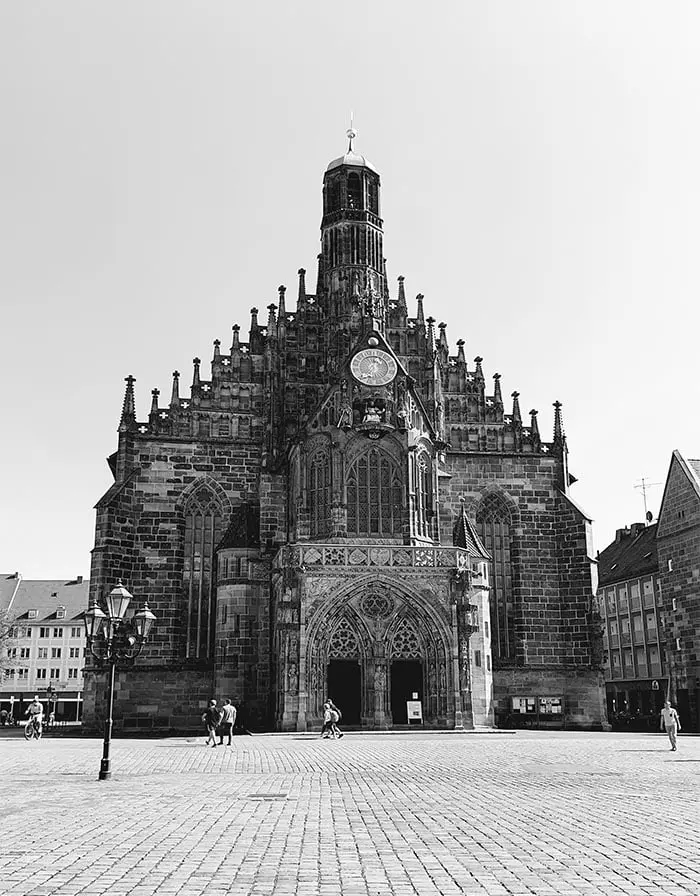
Audio 6: Christkindlesmarkt
Every year at Christmas time, the main market square is transformed into a Christmas city of wood and cloth, the Christkindlesmarkt. The Nuremberg Christkind opens its market every year on the Friday before the first Advent. Around 200 stalls are then set up on the main market square. The traditional offerings - gingerbread, mulled wine, Christmas decorations, handicrafts, toys, and sweets – will stir up the Christmas mood in you.
The Christkindlesmarkt is one of the oldest Christmas markets in Germany. A pre-Christmas sales fair on Nuremberg's main market square can be traced back to the middle of the 16th century. There is evidence that the Christkindlesmarkt was first mentioned in writing in 1628.
Nuremberg's trademarks are world-famous: Although other Christmas markets also sell gingerbread, mulled wine, etc., these marketed products are at home here in the Franconian metropolis - and, according to the people of Nuremberg, Nuremberg has the best of them: the original Nuremberg Elisen gingerbread, the genuine Christkindles mulled wine, the fruit loaf, the Nuremberg bratwurst and, of course, the famous "Zwetschgermoh", the lucky Schlotfeger made from plums, figs, and walnut.
The market opens every year on the Friday before the first Advent with a festive ceremony on the main market square. The Nuremberg Christ-Child, a Nuremberg girl who is elected every two years, must be 16 to 19 years old and taller than 1.60m and should be able to speak the traditional prologue from the gallery of the Frauenkirche. The last day of the market is always December 24.
The Nuremberg Christkindlesmarkt is considered one of the oldest Christmas markets in Germany and it is a deliberately kept traditional. The wooden stalls have red and white fabric roofs. Plastic fir garlands are a taboo, as is a constant stream of Christmas music from a tape recorder.
The audio guide continues with the Nuremberg Toy Museum.
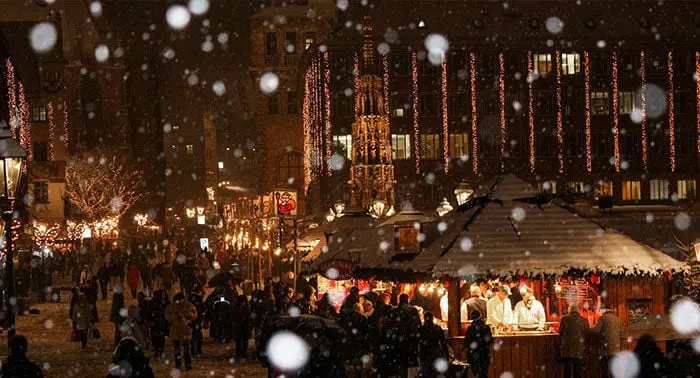
Audio 7: Nuremberg Toy Museum
A must for any family who visits Nuremberg should be the Toy Museum. For more than 600 years, Nuremberg has been the city of toys par excellence. Its tradition stretches from the doll makers of the Middle Ages to outstanding pewter figurine makers and the numerous tin toy manufacturers of the industrial era to the International Toy Fair, the most important trade fair of its kind in the world.
In 1965, the then Nuremberg cultural advisor, Hermann Glaser, succeeded in persuading the community of heirs to sell the collection to Nuremberg as the basis of a new museum. On February 5, 1971, the time had come: the Nuremberg Toy Museum began its operations at Karlstrasse 13-15, where it can still be found today.
A “Welt aus Blech” is presented on the second floor. Vehicles, railroads, mechanical figures, and steam engines demonstrate the outstanding role played by the Nuremberg toy manufacturing facility in the technical field. A highlight is the 30 sqm model railway layout on a scale of 1:64 (S track gauge).
However, it is not only toys from the past that are presented in the Nuremberg Toy Museum: What currently characterizes children's rooms - from Lego to Barbie or Playmobil have their space here, as do Schuco cars, Bobby Cars, and fantasy figures. Child-friendly guided tours with a tour guide and museum educational support are also offered here.
In summer, little visitors can romp around outside on a large fenced-in playground while their parents enjoy a coffee at "La Kritz". A visit to the “shadow empire” in the cellar vault offers a chance to cool off. Here, children big and small experience the fascination of playing with light and shadow - and what influence it had on the development of various optical toys.
The next stop on our audio guide takes us to the “Handwerkerhof” (Crafts Yard).
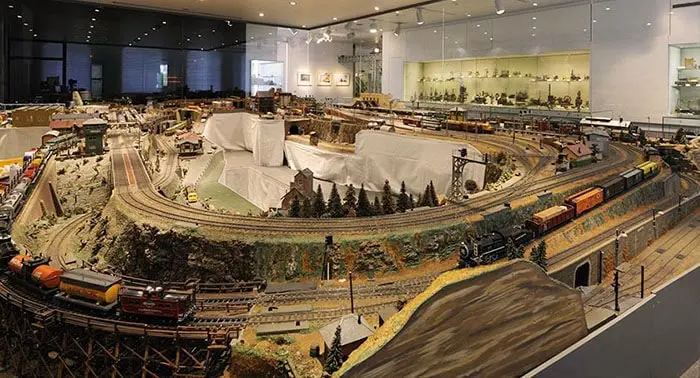
Audio 8: Handwerkerhof (Crafts Yard)
Do you fancy a little trip back in time? Are you interested in traditional craftsmanship and the typical Nuremberg products? Then step into the Handwerkerhof (crafts yard) at the Königstor!
Since its establishment in the “Dürer year” 1971, the Handwerkerhof has delighted millions of visitors. Under the protection of the historic city wall lies the former armory of the imperial city. Step into a world where past times come alive with your audio guide! In the small half-timbered houses and narrow alleys, craftsmen offer their goods for sale; rustic inns invite you to eat and drink, and traditional craftsmanship comes to life.
Look over the shoulders of the master craftsmen, whether in the goldsmith's, in the pewter foundry or with the ceramist, because extremely special products are created here. Take time to experience the hand skills of the fire painter as she decorates wooden signs. Watch leather being worked and "experience" the smell of real leather and then marvel at the tin toys of the Nuremberg companies next door.
And, of course, there are plenty of culinary delights to tempt you: the tempting smell of Nuremberg grilled sausages roasting on the fire wafts through the alleyways; while the inns with special Franconian beer and wine specialties invite you to linger.
The half-timbered houses are a popular photo motif for visitors from all over the world: in the tangle of languages, you can hear Japanese, Chinese, Russian, Italian... The Handwerkerhof is also ideal as a stopover for a jump from the nearby main train station. While the car traffic rushes by outside, there is a homey atmosphere between the old walls. Many passers-by take a break on one of the benches or enjoy a typical Franconian beer in one of the cozy inns.
Go on a historical journey through time with the audio guide and enter the Handwerkerhof!
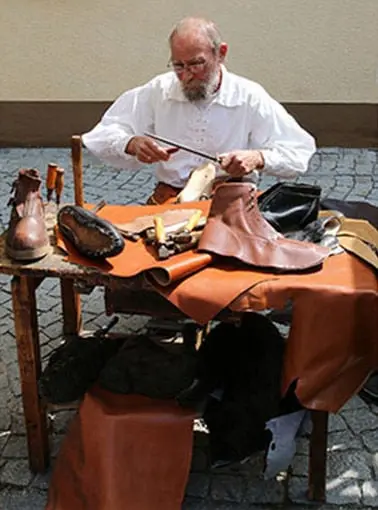
Audio 9: Historic rock passages
The history of Nuremberg is inextricably linked with the history of beer. Following an audio tour of the underground “rock passages” and the Altstadthof home brewery, you can try the traditional Nuremberg red beer.
There were more than 40 breweries in Nuremberg at the end of the 14th century for as little as 30,000 inhabitants. Due to a decree of the city council, anyone who wanted to brew and sell beer had to have their own beer cellar for storing and fermenting the beer. Thus, the origin of the historical rocky passages goes back to the Middle Ages.
Each of these breweries then dug a cellar under the house in the sandstone. The more barley-juice the breweries needed to produce, the larger the cellars had to be. At first, they dug up to four stories deep, and later the cellars were extended horizontally to adjacent properties. In this way, a labyrinth of 25,000 sqm of cellar space was created under what is now Nuremberg's Old Town.
After the cooling machine became more and more important in the field of beer brewing, the cellars became uninteresting for the breweries. In 1912, the Harrer company began to use the rock tunnels for the storage of pickled cucumbers. The cucumbers were brought to the cellars through a pipe system, wherein they were also processed. Today, a sole cucumber barrel still attests to this time.
From 1940 onwards, the cellars below Nuremberg were converted into air raid bunkers. Individual cellars were connected to each other and the city created emergency exits for the population. According to estimates, 35,000 - 40,000 people took shelter in the cellars during the nights when Nuremberg was almost destroyed in its entirety. It was only thanks to this facility that many Nurembergers were able to survive the attacks.
The audio tour continues with the Henkersteg and the Henkerhaus (Executioner’s Bridge and Executioner’s House).
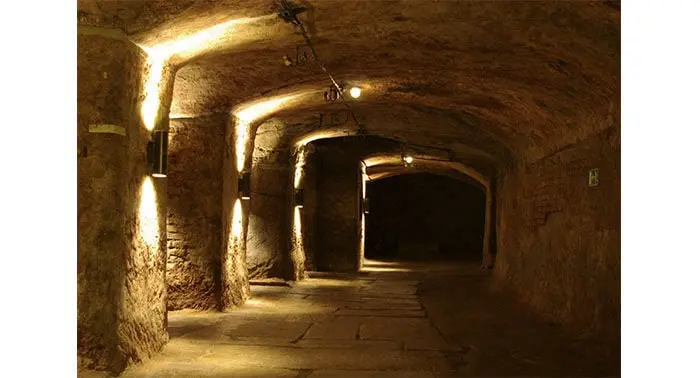
Audio 10: Henkersteg and Henkerhaus
From the 15th to the 19th century, the executioner and his assistant lived here on the outskirts of the city. In the former official residence, the "Henkerhaus", you can now explore an exhibition on Nuremberg's legal history with the audio guide.
The living quarters of the executioner’s House span out romantically on an arched bridge as a covered battlement directly over the Pegnitz River. The water tower and the executioner's tower stand protectively at the beginning and end of the executioner's residence. If one could buy or rent the Executioner's house today, it would certainly be a coveted property.
The Henkersteg is a roofed wooden bridge, which also leads across the Pegnitz, to the Henkerturm - the entrance to the Henkerhaus. The Henkersteg was built around 1320 as a connection between the northern old town - Sebald - and the southern old town - Lorenz - and was initially called "Langer Steg"; 100 years later it was given the name "Henkersteg".
The large square water tower rises majestically between Weinstadel and Henkerhaus. Notches and small windows still testify to its function as a city wall tower. Like the Henkersteg, the water tower was built around 1320.
The city of Nuremberg developed magnificently in the 16th century and became larger and larger. The city’s fortification was extended, and the tower lost its defensive function. Until the end of the 18th century, it and the henkerturm (executioner's tower) were then used as a prison.
However, as romantic as the location seems today, it was by no means so during the executioners' lifetime. Slaughter benches, infirmaries, public baths, and everything else that was smelly and unpleasant surrounded the executioner's residence.
At the end of the 16th century, the former infirmary for lepers became the "Weinstadel" (wine barn), as the municipal wine warehouse was located on the ground floor. The other floors were used for the sick, poor families and craftsmen. The infirmary proved to be unprofitable in the course of time.
The next stop in our Nuremberg audio tour is the St. Lorenz Church.
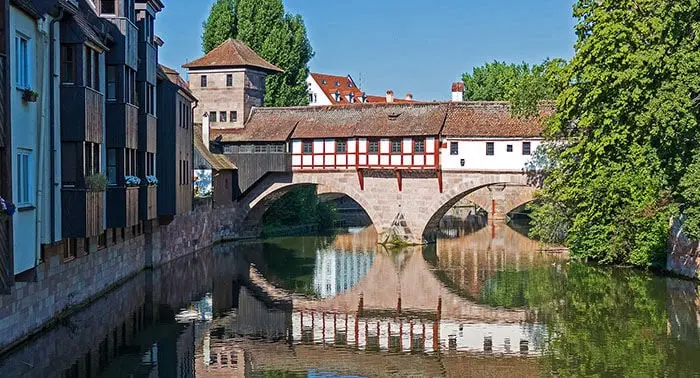
Audio 11: St. Lorenzkirche (St. Lorenz Church)
The Lorenzkirche is one of Nuremberg’s landmark which is visible from afar and is one of the three most important churches. The “Star of St. Lorenz”, a stone rosette with a diameter of 9 m, and the imperial coat of arms welcome the visitor on the west facade. Inside, there are precious testimonies of Nuremberg’s artists and one of the largest organs in the world.
On the site of today's Lorenz Church, there was a Romanesque chapel dedicated by “St. Lorenz to the Holy Sepulcher”. Parts of the old building fabric can still be found today in this impressive High Gothic basilica, the construction of which began between 1243 and 1315. Nuremberg had grown more and more in the Middle Ages and with donations and endowments from the citizens, a representative civic church was built.
If you enter the church with the Audio Guide from the rather dark main portal, the light-filled hall choir with its wonderfully tinted glass windows will still enchant all visitors today.
Famous Nuremberg painters and sculptors contributed to the precious decoration of the Lorenzkirche. Adam Kraft created a tabernacle of impressive beauty with the almost 19 meter high "Sacrament House" made of sandstone. The wooden sculpture "English Greeting" is of comparably high artistic rank and the imperial windows, donated by Emperor Frederick III, were created according to a design by Michael Wolgemut.
The three-part Lorenz organ is one of the largest organs in the world. More than 12,000 pipes and 165 stops make church services and organ concerts in the Lorenzkirche a unique experience. The ringing of the bells is just as sonorous. The oldest of the 16 bells date back to the 14th century, and the restored Feyer bell at the main portal of the Lorenzkirche commemorates the two world wars.
If you take a tour of the tower with the tour guide, you will climb a staircase up the tower to the so-called "balcony" of the tower, wherefrom you can enjoy a great view of the city.
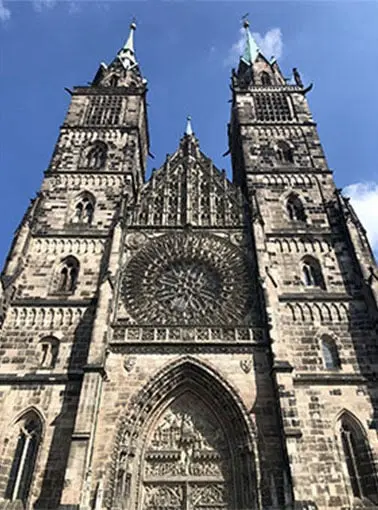
Audio 12: Memorium Nuremberg Trials
The “Schwurgerichtssaal 600” (jury courtroom 600) in the Nuremberg Palace of Justice is world renowned. This is where Nazi criminals such as Hermann Göring and Rudolf Hess had to stand trial after the war. The "Memorium Nuremberg Trials" museum shows the history behind the story.
In 1945, five months after the end of the war, reconstruction work began in the virtually undestroyed Nuremberg Justice Building for the trial of 24 Nazi war criminals. The victorious powers, the USA, the Soviet Union, England, and France, formed the International Military Tribunal, which held a war-crimes tribunal in the legendary Schwurgerichtssaal 600 for the first time in history from November 1945.
The whole world was to be present at this trial. Around 600 trial observers and reporters reported to Nuremberg. For them, the wall where the small windows for Memorium visitors are located today was removed and a two-story visitors' tribune was erected.
Powerful lamps illuminated the hall for the cameramen, who recorded the proceedings from specially installed wall niches. Every word was translated into the four Allied languages, and recorded, thanks to a simultaneous audio system. The documentary material is particularly well known in America.
The federal government, the Free State of Bavaria and the City of Nuremberg spent 4.2 million euros on the 700-square-meter "Nuremberg Trials Memorium. With pictures and documents, the exhibition outlines the course of the trial at that time in an audio tour. The main aim is to illustrate the importance of the trial for the development of an international criminal justice system.
One exhibit of the Memorium is an original bench whereon some of the Nazi celebrities sat during the trial. At the time, a U.S. employee had constructed it in such a way that defendants such as Hermann Göring or Rudolf Heß could only sit on it very uncomfortably. However, the museum itself is also on "historical ground": parts of the attic, which was converted for this purpose, had served as a press gallery during the war crimes trials in 1945/46. This was later removed, and the wall bricked up.
The next stop on our audio guide is the Albrecht Dürer House.
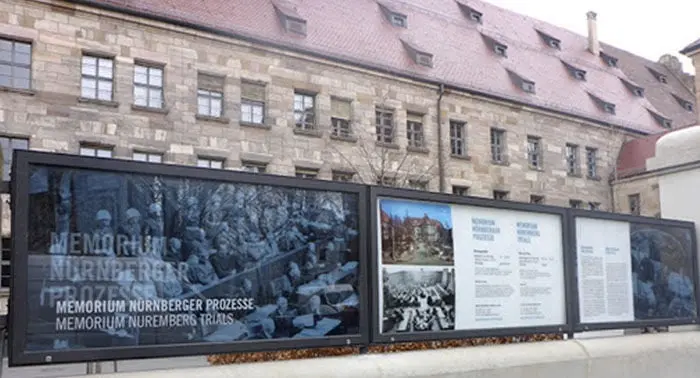
Audio 13: Albrecht Dürer House
From 1509, Albrecht Dürer, Germany's most famous painter, lived and worked in the mighty half-timbered house. It is one of the few undestroyed town houses from Nuremberg's heyday and the only artist's house from the 16th century in Northern Europe.
Since 2010, the Dürer House has undergone a redesign in terms of content. In the entrance area, visitors are now greeted by the master himself in the form of the famous self-portrait from the year 1500. 43 selected works from Dürer's 43 creative years make it possible to experience his life and work in the media station, "The Digital Dürer". Since the end of 2010, the Graphic Cabinet on the 3rd floor has also provided a worthy setting for presenting the graphic works of Albrecht Dürer, his contemporaries and interpreters, as well as those of important graphic artists up to modern times, from the holdings of the Graphic Collection of the City of Nuremberg’s Museums.
2012 saw the opening of the Dürer Hall, wherein his main pictorial work can now be seen in valuable historical copies, alternating with special exhibitions. The last major - and indeed the most important - step, however, is the new visitor guidance system via the Audio Guide, which brings out everything new in the overall context. At all levels of modern museum communication, the Dürer House now provides a lively and interactive insight into the master's work and personality, life, and times.
The largest room, on the second floor, which is illuminated by mild northeast light is the painter's workshop. Here you can follow the most important steps in the process of creating a panel painting and learn many interesting facts about the origin and use of the paints used. In addition, demonstrations of the printing techniques refined by Dürer, such as copperplate engraving and woodcutting, are constantly held here. Opposite the lively workshop, next to a small ink or glue kitchen, is another room where printing takes place. Several times a day, visitors can watch printing demonstrations on the large high-pressure press.
The audio tour of the DB Museum continues.
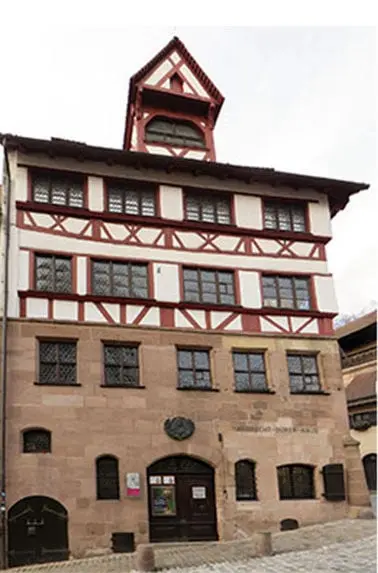
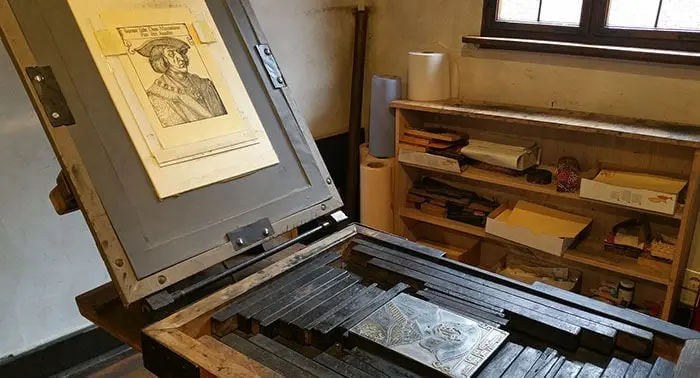
Audio 14: DB Museum and Museum of Communication
The modern décor, however, makes it hard to guess: the DB Museum in Nuremberg, founded in 1882, is probably the oldest railroad museum in the world. And it is equally quite big: on 6,800 square meters, it shows the history of the railroad in Germany from its beginnings around 1800 to the present day - and it also ventures a look into the future.
However, the technical development is only one of several interwoven narrative threads that illustrate via multimedia and audio guide how the railroad has fundamentally changed all areas of human existence and influenced world history. And so everyday things such as the development of travel comfort or the working conditions of railway employees meet here with darker sides, such as the Reichsbahn as the logistical backbone of the war of extermination and the Holocaust.
A separate section is devoted specifically to the era of the German-German division. The main protagonists, however, are the vehicles themselves: A good 40 legends of the railways await visitors in two halls, ranging from Germany's oldest surviving passenger car to a replica of the Adler (the first steam locomotive in Germany) and a design model of the ICE 4. In addition, there is a 15,000-square-foot outdoor area with a historic train platform, interactive signals, and a display depot with treasures from the museum's collections.
In the children's railway land KIBALA, lots of buttons can be pressed; here, driving simulators and a Liliput train await the little visitors, with which they can ride through the entire exhibition area.
In the same building there is also the Museum of Communications, which you can explore on an audio tour. Items on display include signaling instruments, objects related to telephone culture and media development, switching equipment, historic vehicles, archaeological finds related to writing, and historic computers. Media stations explain how children learn to write or how a Chinese secretary masters her typewriter with several thousand characters. Hands-on stations complement these offerings.
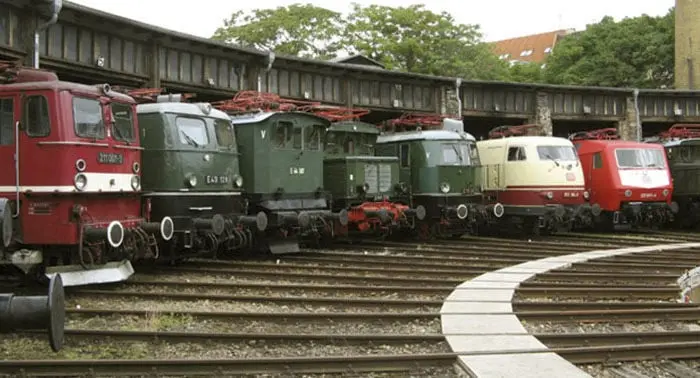
Audio 15: Weißgerbergasse
Weißgerbergasse in the old town of Sebald is one of the best-preserved medieval streets in Nuremberg. It leads from Weinmarkt down to Maxplatz. 22, mostly half-timbered, craftsmen's houses still give a good impression of the architecture and life in narrow streets during the earlier centuries.
The leather-processing trade used to be based here and in Irrerstrasse. The white tanners (also called leatherers or Irrer) produced supple leather from calf, sheep, and goat skins. Because of the high demand for water and the enormous water pollution, the location at the Hallertor above the Pegnitz outflow from the city was ideal for this craft. In vats, which lined the banks of the Pegnitz from the Nägeleinsmühle to the city wall up till 1720, the hides were soaked in several passes and any remaining hair and flesh were removed. The lye made from water, lime, and ash, as well as the alum tanning agent, must have been very smelly. “Stinky skins make rich people” is said to have been a proverb in the past.
In fact, the white tanners seem to have been relatively wealthy people. This can be concluded from the construction of the craftsmen's houses, the upper floors of which were mostly half-timbered.
The profession of the white tanners did not seem to be quite popular in past times. The residents of the alley therefore applied for it to be renamed to “Hallertorgasse”, but this was rejected in 1837 by the government of the Rezatkreis (Middle Franconia) with reference to the historical significance of the street name.
Today, partly to the chagrin of some residents, Weißgerbergasse is a real crowd puller, through which audio tours are also offered. In addition to various stores, bars & restaurants, the residential properties, especially those on the upper floors of the half-timbered houses are particularly popular.
The next stop on the audio guide takes you to the Germanic National Museum.
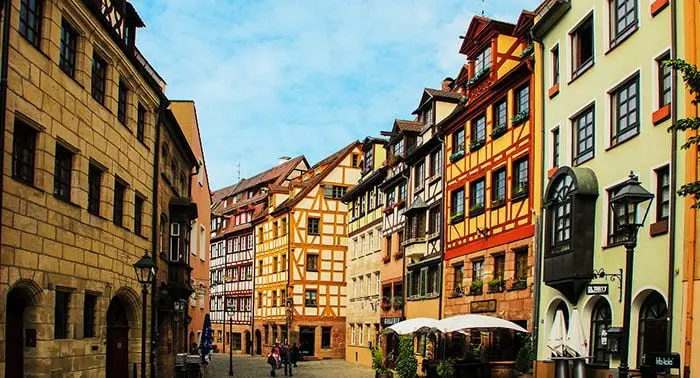
Audio 16: Germanic National Museum
A highlight which you should certainly have seen during a visit to Nuremberg! The Germanic National Museum - with 1.3 million collected objects the largest cultural history museum in the German-speaking world - impresses with a comprehensible and lively presentation of priceless testimonies of artistic and cultural history from the German-speaking world and offers oases of peace and lingering, embedded in an impressive architectural overall picture.
Embark on an exciting discovery journey from prehistory through early history to the present day with the audio guide. Whether you have an hour or a day, come along on a tour across the centuries. Presented in a unique architectural ensemble, a visit to the largest museum of cultural history in Germany will be a special experience.
At the center is a late medieval Carthusian monastery with cloisters, church, and monks' houses. Neo-Gothic building sections, the glass museum forum and the "Street of Human Rights" created by Israeli sculptor Dani Karavan give the museum its present-day character.
It is the collections on art and culture that make the Germanic National Museum in Nuremberg so valuable. Explore up close the mysterious gold cone of Ezelsdorf-Buch from the Bronze Age, the precious medieval binding of the Codex Aureus, the oldest globe in the world as well as sculptures by Veit Stoß and masterpieces by Albrecht Dürer, Lucas Cranach, Rembrandt, Carl Spitzweg and Ernst Ludwig Kirchner. There is no other place where the cultural history of the German-speaking world can be experienced in all its facets.
The last stop on our audio guide is the zoo.
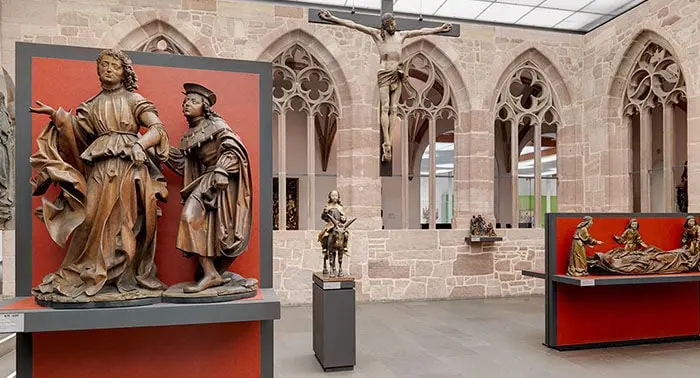
Audio 17: The Nuremberg Zoo
A visit to the Nuremberg Zoo with the audio guide is a great experience for anyone, regardless of whether you come from a big city or a rural area. Here, you will have a unique opportunity to relax and observe even the animals from the most distant countries. Nuremberg Zoo specifically stands out by the fact that most of the animals live in outdoor enclosures and thus can maintain their natural way of life.
The zoo, which was relocated from the Nazi Party Rally Grounds to Schmausenbuck in 1939, is dedicated not only to the classical zoo animals but also to the preservation and reproduction of endangered species. The zoo offers many extras to young visitors, such as a children's zoo with play facilities and a petting enclosure.
In its current form, the Nuremberg Zoo offers numerous outdoor enclosures and open-air spaces on about 67 hectares. These include a hoofed animal enclosure, wherein zebras, Asian wild horses, various antelope species, several deer species, Solami wild asses, and so-called takins are housed. In 1997, the zoo was expanded to include an outdoor enclosure for gorillas.
Upon entering the grounds, zoo visitors will probably first notice the giraffe house and squirrel monkeys, which roam in a large outdoor enclosure with trees. When visiting the tropical house, tapirs, pygmy hippos, and manatees can be seen either in their pools or through viewing windows underwater. In addition, pygmy marmosets, sloths, and ducks have been housed in the tropical house to guarantee action.
In 2001, the zoo was enhanced by the addition of another attraction: the water park which was created for sea lions and otters. Here, too, visitors have the possibility of observing the animals under water.
The latest highlight is the Dolphin Lagoon, which was opened together with the Manatee House - a tropical house with free-flying butterflies - in summer 2011. The Dolphin Lagoon remains the only outdoor facility for dolphins in Germany.
Enjoy your visit of Nuremberg with the audioguide!

Audio guide devices, Multimedia audio guides,
Audio guide GPS tourist bus-train, charging bases and accessories.
Group guidance systems, headsets, charging cases, tour guide systems accessories.
Audioguides available from mobile devices, web App, downloadable App from Google Store.
Audioguides in several languages, translations, voiceovers. Audio descriptions, signoguides, visual contents for audioguides. 3D Reality.